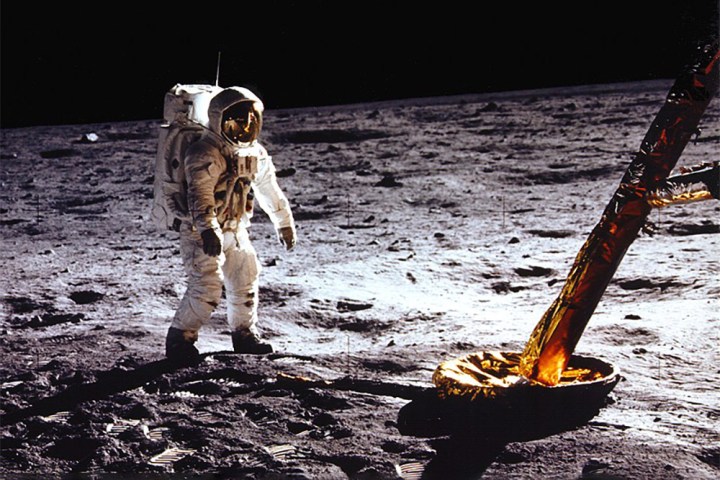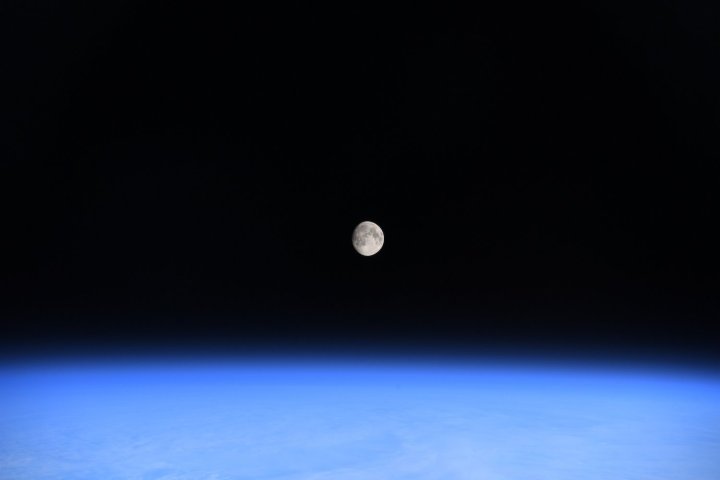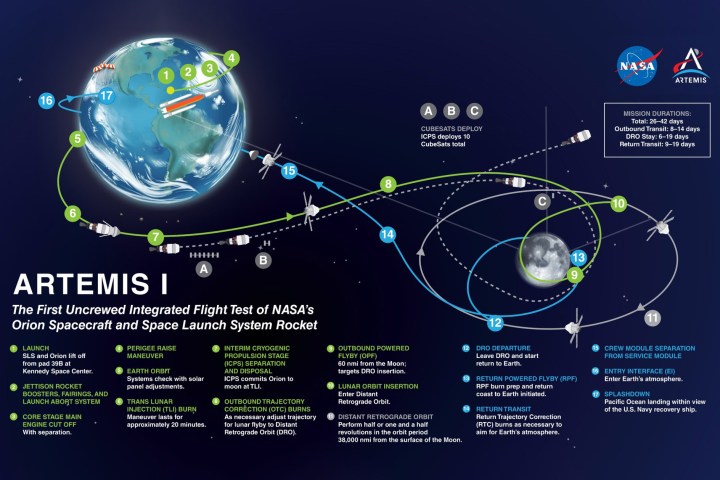“Magnificent desolation.”
Those were the words used by Buzz Aldrin to describe the vast emptiness of the lunar landscape prior to stepping onto its surface for the first time in July 1969. But what if the moon – or, rather, its orbit – wasn’t so desolate after all? What if it was more akin to, say, the gridlocked traffic of a rush hour Los Angeles commute? What if indeed?

Given that a grand total of 12 people have walked on the moon’s surface in human history, that may seem a mighty big hypothetical. However, it’s also a troubling notion that researchers from the University of Arizona, a university that helped map the surface of the moon for Aldrin’s famous Apollo 11 mission, are currently giving a whole lot of thought.
Their plan – for which the university recently received $7.5 million in funding from the Air Force Research Laboratory’s Space Vehicles Directorate – calls for what is, in essence, the world’s first lunar air traffic control system. Intended to keep tabs on space traffic in the currently untracked cislunar region between our planet and the moon, it will help avoid lunar traffic jams – and, perhaps, even deadly collisions.
And it’s coming sooner than you think to a moon mission near you.
Like a discarded car lot in space
It was the NASA scientist Don Kessler who, in 1978, first pointed out the danger posed by the extremely high density of objects that circulate in low-Earth orbit and the way that these could trigger a cascading chain reaction of possible collisions. (Watch the start of the 2013 movie Gravity to see how devastating this could be.)
Today, there are around 23,000 pieces of space junk being tracked as they whiz around the Earth at speeds of around 17,500 miles-per-hour. Of these, just 3,500 are active payloads, while the remainder – everything from dead satellite nubs to discarded rocket parts – are inactive, but still potentially dangerous, debris.
“Let’s imagine that, since the invention of the automobile, you take the car from the factory and put gas in it, then [drive it until it runs out of gas], drop it, and pick up a new car,” Vishnu Reddy, an associate professor in the University of Arizona Lunar and Planetary Laboratory, said to Digital Trends. “That’s what we’ve been doing in space. Every time a spacecraft runs out of fuel – and it might be a perfectly working spacecraft – you drop it and launch a new payload. [Over time] things get accumulated.”
The problem, he said, is one of visibility: Both literal and figurative. “Space is kind of an intractable problem,” Reddy explained. “It’s not like an environmental catastrophe, right? You know, there’s an oil spill, you see the pelicans covered in oil, that triggers a visceral reaction. You show a dot in the sky to anybody and most people don’t care. It’s like, why should I care – until the cell phone stops working or the GPS stops working or the football stops playing on the TV. That’s when people react.”
Lunar orbit-polluting debris

While earth-orbiting space junk has received a bit of attention, the lunar space junk problem is largely uncovered. That’s because, for now at least, this isn’t a problem.
By Reddy’s own admission, the lunar orbit channel is- currently still relatively clear. Compared to the thousands of cataloged objects that orbit Earth, there are just a few dozen payloads orbiting the moon. Of the small handful of satellites in lunar orbit, the only notable ones (possibly the only ones entirely) include the NASA Lunar Reconnaissance Orbiter, two Artemis spacecraft (P1 and P2), and China’s Chang’e 5-T1. That’s less major congestion than it is the equivalent of spotting another car during a multihour drive through rural Wyoming.

But just because it’s Wyoming today doesn’t mean it’s not the L.A. freeway tomorrow. Or, to avoid exaggeration, at least a fair bit busier than it is at present.
“We had the initial exploration of the moon in the [1960s],” said Reddy. “Then there was a quiet period in the middle, for the last 50 years or so. But now there’s a renewed interest in lunar exploration. Over the next eight years, we’re expecting up to 50 payloads going to the moon. We want to avoid the kind of situation that we have on the Earth [taking place] around the moon, in lunar orbit, too.”
This could also prove disruptive to satellites and potentially hazardous to space flight missions – both crewed and uncrewed.
The idea of taking a proactive approach to air traffic control isn’t new, of course. It’s exactly what happened with traditional, terrestrial air traffic control. The first serious attempts to develop rules for monitoring and controlling air traffic came into being in 1922, several years after the inaugural International Air Convention of 1919. The first person who could officially refer to themselves as a professional air traffic controller, Archie League from St. Louis, Missouri, began working in 1929. Although air travel was starting to take off (pun semi-intended) at that time, it was in its infancy compared to what it would become. With 173,000 passengers flying in the U.S. in 1929, compared to 926 million passengers transported in 2019, the skies weren’t exactly crowded. Nonetheless, it was deemed that a solution was needed – even if it was likely to be based on projected growth.
‘I come from the asteroid-tracking world’
As the saying goes, the first step in solving any problem is to recognize that there is a problem to begin with. When it comes to solving a problem of this complexity, however, admitting the problem is far from the biggest hurdle. Fortunately, at least initially, Reddy said that a lot of the current technologies used for tracking objects from Earth can be appropriated for tracking lunar orbits.
Reddy and his students in the Lunar and Planetary Laboratory are using dedicated sensors at the university’s Biosphere 2 research facility in order to characterize cislunar objects. This equipment suite includes multiple telescopes that are dedicated to space domain awareness, including one that was built by a group of University of Arizona engineering undergraduates.
“A lot of it can be done with [the ground-based optical telescopes] we already have for doing geostationary stuff,” Reddy said. “It’s just that they’re fainter, so you have to expose the image for a long time and take a picture that is deeper.”
His own background, he noted, is “primarily doing planetary defense.” “I come from the asteroid-tracking world, so a lot of the tools we’re applying to this particular problem rely on planetary defense tools and technologies,” he explained. “The asteroid community has been tracking really small objects, far out from the Earth, for decades. We’re leveraging a lot of the software and techniques [for this project].”
I want to be a lunar model
The ultimate goal of this project – and it’s already further along than you might think – is to build a model that accurately shows every object orbiting the moon. It will then highlight possible conjunctions (the fancy space-term for crashes) between these objects and active payloads. Reddy said that the tool will be used for this year’s Artemis 1 launch, the debut of NASA’s super heavy-lift launch vehicle, with the goal of sending an uncrewed Orion spacecraft on a retrograde orbit of the moon.

The researchers will also make their model available to private space companies. “If a manufacturer comes to us and says, ‘Hey, we’re doing this mission to the moon, can you please check for conjunctions?’ Yes, sure,” Reddy said. “That’s a service we will provide. We want to avoid the creation of debris. It’s more work for us to track a lot of things. Not that we’re lazy, but if we can avoid it and keep [lunar orbit] clean, that’s better for us all.”
A good question is how much enforcement power a space traffic control system like this would have. Let’s say, for the sake of argument, that a Chinese satellite poses a possible existential threat to an American space launch – or, when this airspace becomes more populated, two craft risk a possible collision. Who gets to be the one who claims right of passage in a possible extraterrestrial game of chicken? Tough question. “I don’t think we have any enforcement capability,” Reddy said. “This is more of an academic exercise [right now].”
Another future challenge, yet to be unpacked, could involve launching actual space missions to deploy additional orbital assets that can help monitor areas not visible from Earth, such as objects hidden behind the moon. (Who knows: This could even serve as a trial run for similar initiatives on other planets like Mars, which would require the laying down of completely new infrastructure due to the difficulty of monitoring them from Earth. “I think we’re already planning to do something about space traffic management around Mars,” he said.)
For now, though, the team will be happy if this proof of concept demonstrates its worth as a tool to support our continued space interests – and revived fascination with the moon.
“Our goal is to mature this and demonstrate that something like this can be maintained and can be useful,” Reddy said. “Then we’ll pass it onto the people who have the real responsibility for keeping this going.”


